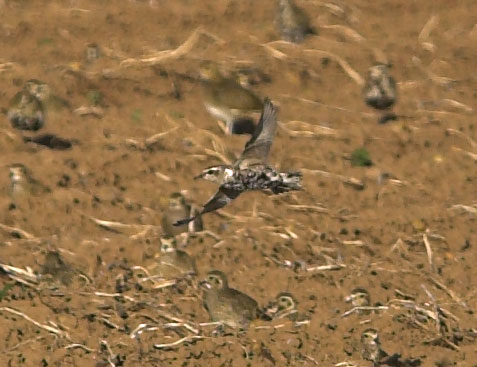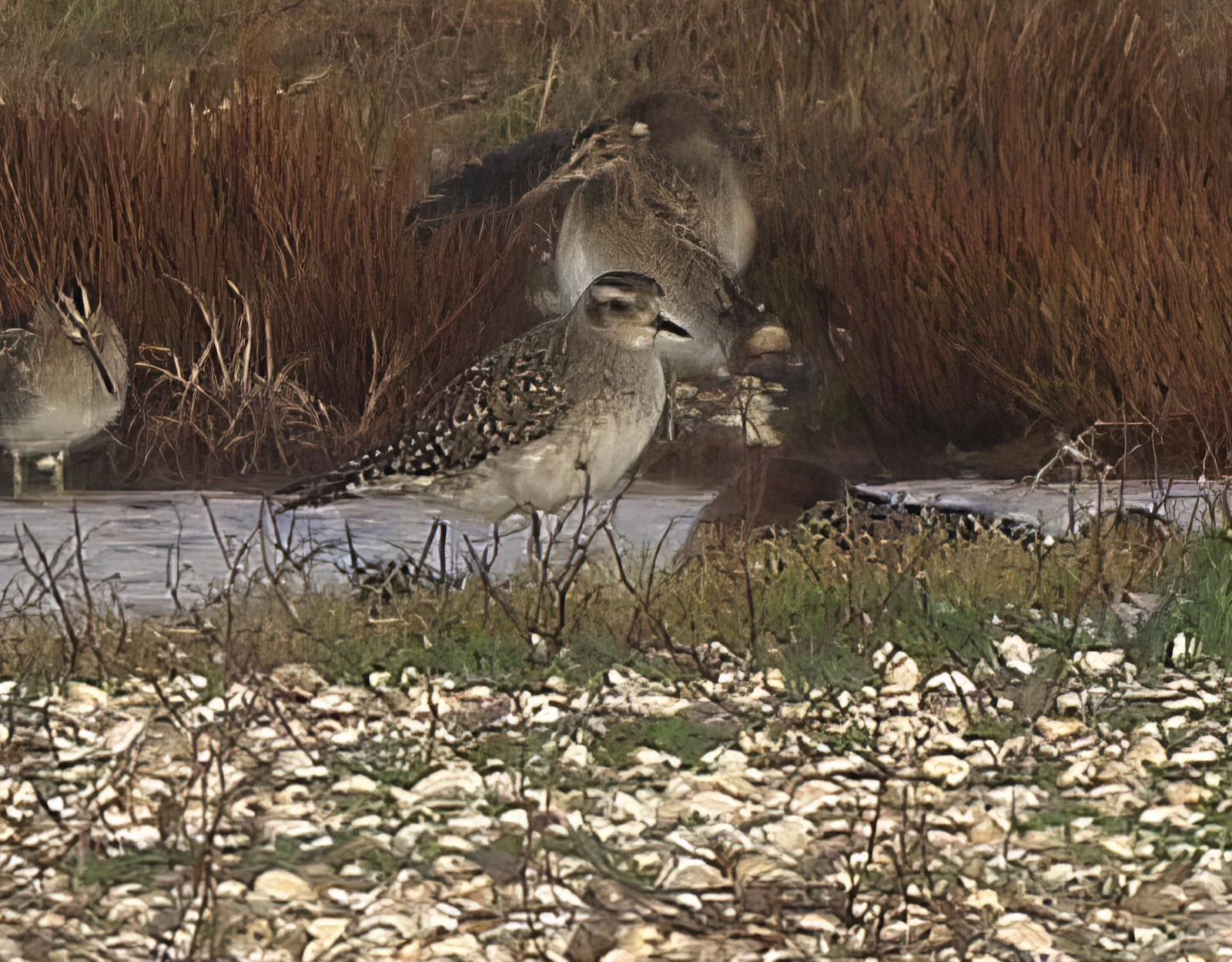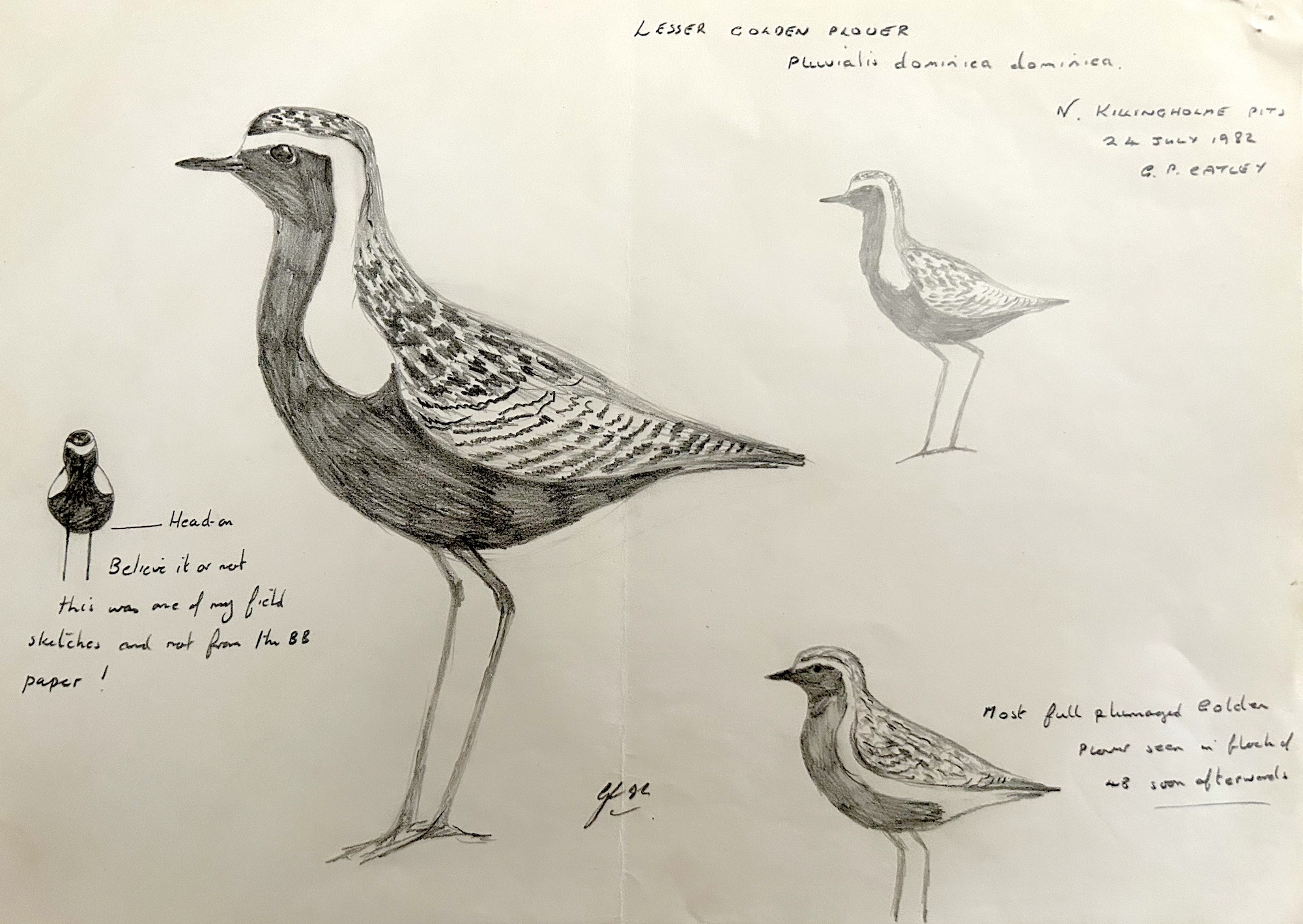American Golden plover Pluvialis dominica


Formerly known as Lesser Golden Plover, Pluvialis dominica, the species was split into American Golden Plover, P. dominica, and Pacific Golden Plover, P fulva, by the BOURC in 1986, prior to which there had been only seven British records of Pacific. By 2005 the total had risen to 60, compared with 275 American Golden Plovers.
The first county record was found at Wisbech Sewage Farm on August 19th, 1974. There have been a further 23 confirmed records involving 24 birds, the earliest on May 9th (the only spring record) and the remainder in autumn July 24th-November 4th; remarkably there have been four records on July 24th. Of those which were aged, 15 were adults, three were 2CY and four were juveniles. The 2CY birds were seen in May, June and September while the juveniles were seen in October (2) and November (2). Most were recorded in July (7) and October (9). Since 2000 there have been records in 2005-8, 2010, 2013 and 2018-19. The most recent of these was of an adult at Frampton Marsh on September 22nd and 25th 2019. It is noteworthy that both American and Pacific Golden Plovers do not complete their moult into winter plumage until they reach their winter quarters and retain variable amounts of black underpart feathering during their autumn migration. European Golden Plovers complete their moult by September-October. Thus both Pacific and American may retain traces of summer plumage well into the winter which can be an aid to identification.
| Site | First date | Last date | Count | Notes |
| Wisbech STW | 10/08/1974 | 1 | Adult, reported to be P. dominica by L&A (1989) | |
| North Killingholme Pits | 24/07/1982 | 1 | Adult | |
| Saltfleetby-Theddlethorpe NNR | 16/07/1983 | 1 | Adult | |
| Tetney marshes | 27/07/1986 | 29/07/1986 | 1 | Adult |
| South Ferriby | 24/07/1993 | 1 | Adult | |
| Holbeach Marsh | 24/07/1994 | 24/07/1994 | 1 | Adult |
| Butterwick Marsh | 08/10/1994 | 16/10/1994 | 1 | Adult, 8th and 16th only |
| Frampton Marsh | 03/09/1995 | 1 | 2CY | |
| South Ferriby/ Read's Island | 24/07/1997 | 13/08/1997 | 1 | Female or 2CY |
| Huttoft Bank | 09/05/1998 | 1 | 2CY | |
| Frampton Marsh | 02/10/2005 | 1 | Adult | |
| East Ferry | 02/10/2006 | 1 | Moulting adult | |
| Deeping High Bank/ Crowland Common area | 06/10/2006 | 09/10/2006 | 1 | Moulting adult |
| Deeping High Bank/ Crowland Common area | 28/10/2006 | 1 | 1CY | |
| East Butterwick | 06/09/2007 | 1 | Moulting adult | |
| East Butterwick | 07/09/2007 | 08/09/2007 | 2 | One individual from 6th, two 7th-8th. |
| Dawsmere | 14/10/2007 | 1 | 1CY | |
| Fillingham Lake | 04/11/2008 | 05/11/2008 | 1 | 1CY |
| Freiston Shore | 31/10/2010 | 01/11/2010 | 1 | 1CY |
| Donna Nook | 04/10/2013 | 1 | 1CY | |
| Susworth | 05/10/2013 | 1 | Adult | |
| East Butterwick | 05/10/2018 | 1 | Adult | |
| Frampton Marsh | 22/09/2019 | 1 | Adult | |
| Frampton Marsh | 25/09/2019 | 1 | Adult, same | |
| Frampton Marsh | 17/05/2023 | 1 | Adult in summer plumage |
Finder’s report: American Golden Plover at North Killingholme Haven, July 24th, 1982, second county record
by G. P. Catley
Note: This account is based on the original BBRC submission. At the time, Lesser Golden Plover Pluvialis dominica hadn’t been split into American Golden P. dominica and Pacific Golden P. fulva Plovers. It was the second record for Lincolnshire; we do not have a copy of the RC submission for 1974, the first county record. With the hindsight of scrutiny which was applied to all ‘Lesser Golden Plover’ records after the split, this 1982 record was one of six that year which brought the then British total to 52 since 1950.
Circumstances
Whilst checking the waders on the reserve at North Killingholme Haven on July 24th, 1982, I was sitting in my car when a ‘plover’ flew past me and landed on some open mud which had recently been cleared of Sea Aster. My first impression was of a Grey Plover with some gold on the mantle, and although I had no previous experience of the species, I was convinced that it was a Lesser Golden Plover. I watched the bird from 40m. from my car for five minutes as it fed on the mud. It was then chased by a lone Lapwing and flew towards me giving me a fleeting view of the underwing. About five minutes later it began to call loudly and suddenly flew off directly away from me and rising quickly, flying around in a large arc, and apparently dropping on to some fields which were being ploughed about two miles away. Although it appeared to land on these fields, where there were about 2,000 Lapwing, 48 Golden Plover and some Ruffs were feeding, it could not be found again despite thorough searching. It apparently arrived at the pits alone, and also left alone.
Description
General appearance – it was akin to a bright summer-plumaged Golden Plover with longish legs.
Head and underparts- crown dark, blackish with a few gold specks; nape grey-brown with some blackish lines. A broad white line started above the bill, continued over the eye, and broadened behind the eye, turning abruptly down on to the side of the neck (at an angle of about 900), narrowing down the neck and then broadening again into a large oval shape on the sides of the breast about level with the bend of the wing where it ended abruptly. Underparts from chin to tips of undertail coverts a pure black except for one small, moulted patch on the flanks on one side of the bird which was a creamy colour with faint darker bars. Underwings were not seen well but on landing once they appeared a buffy-grey in contrast to Golden Plovers seen later. Unfortunately, the axillaries were not seen as when in flight, the bird either flew towards me or directly away!
Upperparts - mantle largely dark blackish-brown with some gold spangles but nothing like the colour or density of Golden Plovers. Wing coverts and flight feathers gave the impression of being barred alternately blackish and creamy-buff. Primaries dark, greyish and wings with quite long tips projecting beyond the tail. Upperwing showed a very short pale wing bar and had some feathers missing like most of the Golden Plovers.
Bare parts – bill looked blackish and long. Legs were quite long and blue-grey, quite a noticeable colour. Compared to Golden Plovers later, it became apparent that this bird appeared to show a greater length of leg above the knee than that species.
Call - when chased by a Lapwing it gave a short ‘peet’ call. When it took off, it uttered a very distinct 'tlooit' call in flight repeatedly, rather like a melodic Spotted Redshank.
Behaviour – in flight it looked quite long winged, and flight action was typically rapid. When feeding the comparison with Grey Plover was accentuated by the high stepping gait and the very deliberate picking action, a fine distinction from Golden, possibly emphasised by the longer looking neck and more angular head.

Sketches of the American Golden Plover, July 24th, 1982, from the original BBRC submission by Graham Catley.
(Account as per new Birds of Lincolnshire (2021), included September 2022; finder's report added May 2023)

